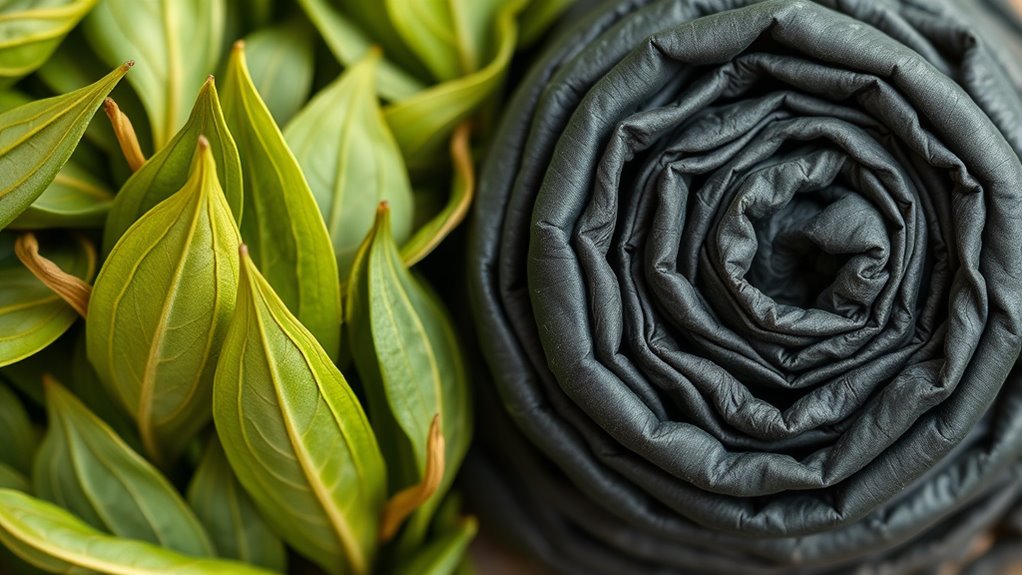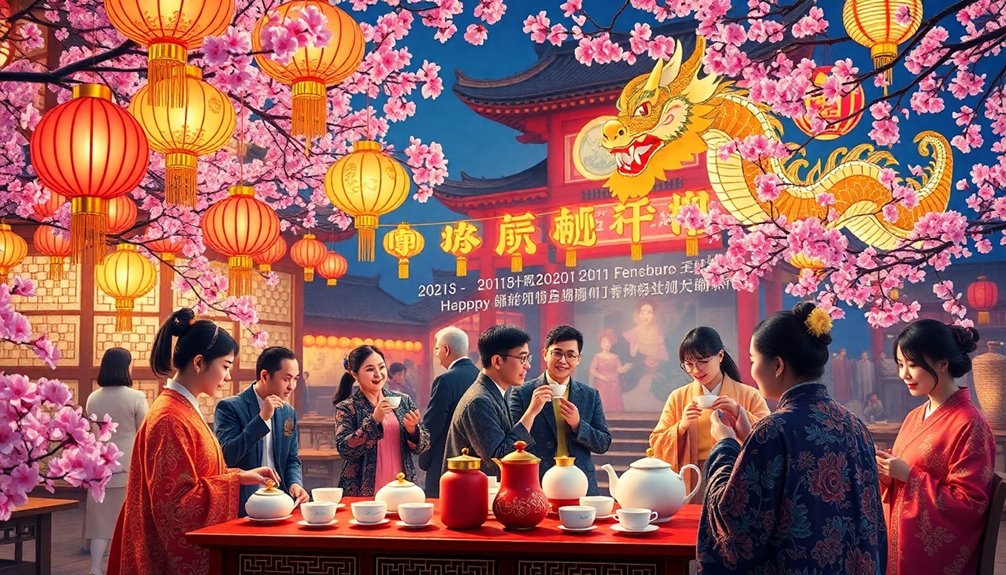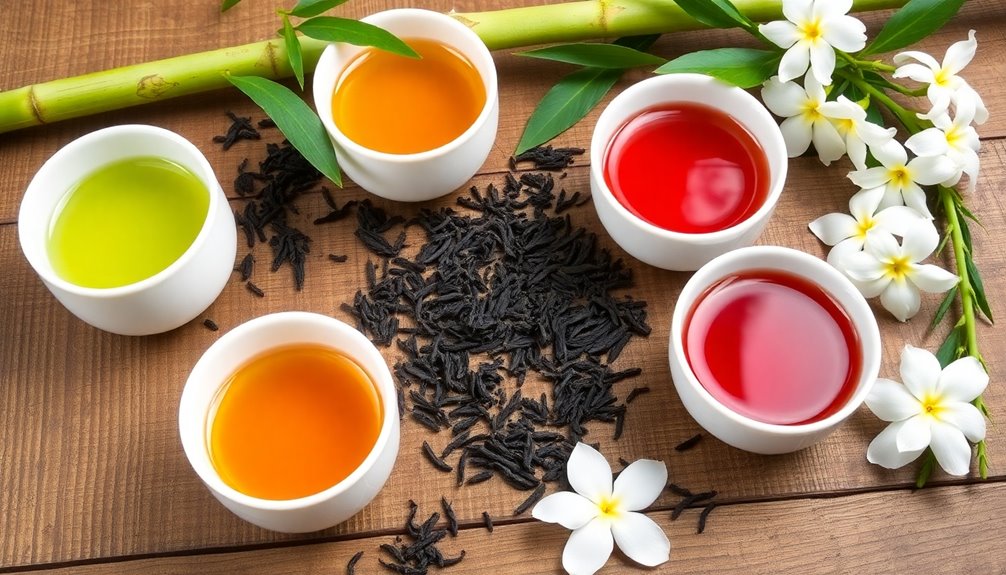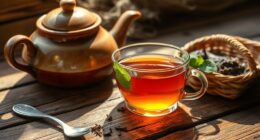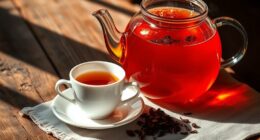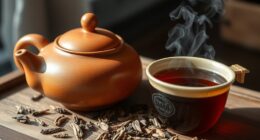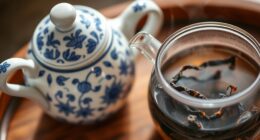Sheng and Shou Pu-erh differ mainly in their processing methods. Sheng undergoes minimal natural fermentation, using sun-drying and aging over time to develop complex flavors. Shou, on the other hand, is quickly fermented through a process called “wet piling,” which produces a dark, earthy tea ready to enjoy sooner. These methods shape each tea’s flavor, aging potential, and characteristics. Want to understand more about how these differences impact your tea experience? Keep exploring.
Key Takeaways
- Sheng Pu-erh undergoes minimal, natural fermentation, mainly sun-drying, while Shou Pu-erh uses accelerated microbial fermentation via piling.
- Sheng’s fermentation is slow and aging naturally over time; Shou’s fermentation is quicker, producing a dark, earthy flavor instantly.
- Sheng tea matures through long-term storage and aging; Shou can be enjoyed immediately after processing or further aged.
- Sheng develops complex, evolving flavors with age; Shou offers a consistent, mellow, earthy taste early on.
- Processing methods directly influence flavor profiles, aging potential, and the time needed to appreciate each tea type.
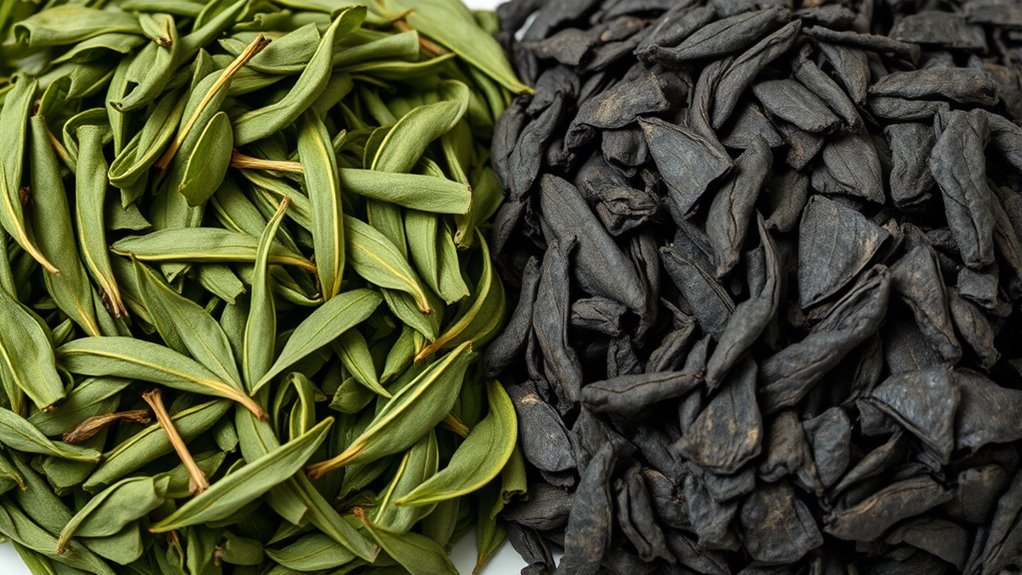
Have you ever wondered what distinguishes Sheng from Shou Pu-erh tea? The key differences lie in their processing methods, particularly the fermentation process and aging techniques. Sheng Pu-erh, often called “raw” Pu-erh, undergoes minimal fermentation initially. After harvesting, the tea leaves are sun-dried and then pressed into cakes or bricks, allowing natural oxidation and slow aging over time. This aging process can stretch over decades, during which the tea develops complex flavors and a smoother profile. Because Sheng tea has not been artificially fermented, it retains a fresh, grassy, or astringent taste in its early years, and only gains depth as it matures. The aging techniques for Sheng involve storing it in controlled environments to allow natural fermentation and oxidation, which gradually transform its flavor profile. Proper storage techniques are essential to ensure the tea ages gracefully and develops desirable characteristics over time.
In contrast, Shou Pu-erh, known as “ripe” Pu-erh, is processed with a more accelerated fermentation method. After the initial drying and shaping, the leaves are subjected to a controlled fermentation process, often called “wet piling” or “wo dui.” During this phase, the tea is piled, moistened, and kept at specific temperatures to promote microbial activity. This process, which typically lasts a few months, artificially speeds up fermentation, giving the tea its characteristic dark color and earthy aroma. The purpose of this method is to replicate the aging that Sheng Pu-erh achieves naturally over many years, but in a much shorter time. Once fermented, Shou Pu-erh can be enjoyed immediately or aged further, but it generally matures faster and develops a mellow, earthy, and smooth flavor profile early on.
The fermentation process is what truly sets Sheng and Shou apart. Sheng’s fermentation is slow and natural, emphasizing patience and long-term aging, while Shou’s fermentation is deliberately accelerated with controlled microbial activity. As a result, Sheng Pu-erh often appeals to those who enjoy exploring the evolving flavors of aged teas, while Shou caters to those seeking a rich, earthy taste right after processing. Both types benefit from different aging techniques—Sheng requires patience and proper storage conditions to mature gracefully, whereas Shou is more accessible but can also be aged further to deepen its flavor. Understanding these distinctions helps you choose the right Pu-erh based on your taste preferences and willingness to wait or enjoy immediate richness.
Frequently Asked Questions
How Do Aging Processes Differ Between Sheng and Shou Pu-Erh?
You’ll notice that aging processes differ markedly between sheng and shou pu-erh. Sheng undergoes a longer fermentation duration, often years, allowing it to develop complex flavors naturally over time. Shou, on the other hand, uses controlled aging techniques with accelerated fermentation, which shortens the process. This makes shou ready sooner, but both types evolve uniquely as they age, creating distinct taste profiles that reflect their aging methods.
What Are the Health Benefits Specific to Each Type?
Did you know that drinking pu-erh can boost your health? Sheng pu-erh offers strong antioxidant properties that may help fight free radicals, while shou pu-erh is known for aiding digestion due to its fermentation process. Both types can support your overall health, but sheng’s antioxidants may protect cells, and shou’s digestion benefits can soothe your stomach. Incorporate these teas into your routine for a natural wellness boost.
Can Sheng Pu-Erh Be Aged Like Fine Wine?
You can age sheng pu-erh like fine wine by using proper storage techniques, which involve controlling humidity, temperature, and light exposure. Fermentation techniques during initial processing allow it to develop complex flavors over time. By maintaining ideal storage conditions, you encourage natural aging, enhancing its taste and value. So, with patience and careful storage, sheng pu-erh can indeed improve and mature beautifully over the years.
Are There Regional Differences in Processing Sheng and Shou Pu-Erh?
You’ll find regional variations and cultural influences markedly shape how sheng and shou pu-erh are processed. In different areas, traditional methods, climate, and local preferences lead to unique fermentation and drying techniques. For instance, some regions emphasize natural aging, while others focus on specific roasting styles. These regional differences give each batch its distinctive flavor profile, reflecting local customs and environmental conditions that influence production methods and final taste.
How Do Storage Conditions Affect Flavor Development in Both Types?
You should consider how storage humidity and fermentation environment influence flavor development in both sheng and shou pu-erh. High humidity accelerates aging and enhances mellow, complex flavors, while low humidity preserves freshness. A controlled fermentation environment allows subtle changes over time, deepening taste. Proper storage guarantees consistent aging, preventing spoilage, and helps develop nuanced flavors unique to each tea type. Adjusting these conditions tailors the flavor profile to your preferences.
Conclusion
As you sip your sheng or shou pu-erh, imagine walking through a lush tea forest, where sunlight filters through leaves, shaping each leaf’s journey. Sheng’s vibrant, raw energy awakens your senses like a brisk morning breeze, while shou’s mellow, earthy notes wrap you in a warm, comforting embrace. Whether you crave the lively sparkle or the soothing embrace, understanding their differences lets you truly enjoy each sip’s story, making every cup a delightful adventure.

